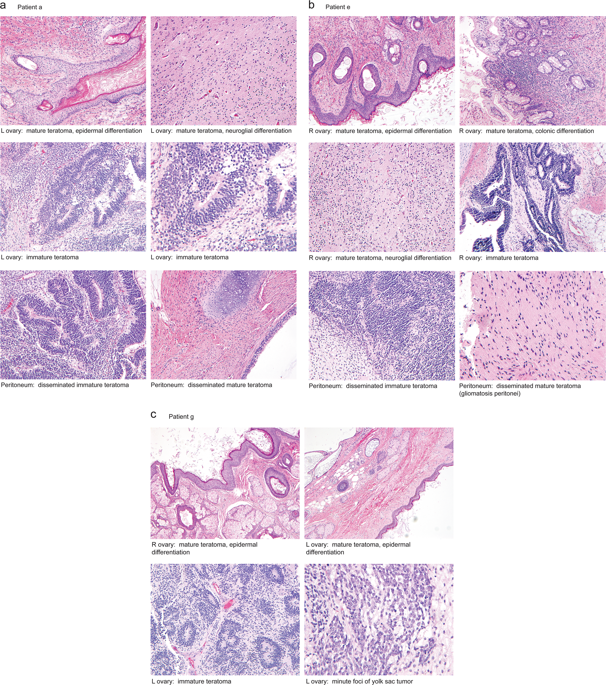当前位置:
X-MOL 学术
›
Modern Pathol.
›
论文详情
Our official English website, www.x-mol.net, welcomes your
feedback! (Note: you will need to create a separate account there.)
Multiregion exome sequencing of ovarian immature teratomas reveals 2N near-diploid genomes, paucity of somatic mutations, and extensive allelic imbalances shared across mature, immature, and disseminated components.
Modern Pathology ( IF 7.1 ) Pub Date : 2020-01-07 , DOI: 10.1038/s41379-019-0446-y Michael B Heskett 1 , John Z Sanborn 2 , Christopher Boniface 1 , Benjamin Goode 3 , Jocelyn Chapman 4 , Karuna Garg 3 , Joseph T Rabban 3 , Charles Zaloudek 3 , Stephen C Benz 2 , Paul T Spellman 1 , David A Solomon 3 , Raymond J Cho 5
Modern Pathology ( IF 7.1 ) Pub Date : 2020-01-07 , DOI: 10.1038/s41379-019-0446-y Michael B Heskett 1 , John Z Sanborn 2 , Christopher Boniface 1 , Benjamin Goode 3 , Jocelyn Chapman 4 , Karuna Garg 3 , Joseph T Rabban 3 , Charles Zaloudek 3 , Stephen C Benz 2 , Paul T Spellman 1 , David A Solomon 3 , Raymond J Cho 5
Affiliation

|
Immature teratoma is a subtype of malignant germ cell tumor of the ovary that occurs most commonly in the first three decades of life, frequently with bilateral ovarian disease. Despite being the second most common malignant germ cell tumor of the ovary, little is known about its genetic underpinnings. Here we performed multiregion whole-exome sequencing to interrogate the genetic zygosity, clonal relationship, DNA copy number, and mutational status of 52 pathologically distinct tumor components from ten females with ovarian immature teratomas, with bilateral tumors present in five cases and peritoneal dissemination in seven cases. We found that ovarian immature teratomas are genetically characterized by 2N near-diploid genomes with extensive loss of heterozygosity and an absence of genes harboring recurrent somatic mutations or known oncogenic variants. All components within a single ovarian tumor (immature teratoma, mature teratoma with different histologic patterns of differentiation, and yolk sac tumor) were found to harbor an identical pattern of loss of heterozygosity across the genome, indicating a shared clonal origin. In contrast, the four analyzed bilateral teratomas showed distinct patterns of zygosity changes in the right versus left sided tumors, indicating independent clonal origins. All disseminated teratoma components within the peritoneum (including gliomatosis peritonei) shared a clonal pattern of loss of heterozygosity with either the right or left primary ovarian tumor. The observed genomic loss of heterozygosity patterns indicate that diverse meiotic errors contribute to the formation of ovarian immature teratomas, with 11 out of the 15 genetically distinct clones determined to result from nondisjunction errors during meiosis I or II. Overall, these findings suggest that copy-neutral loss of heterozygosity resulting from meiotic abnormalities may be sufficient to generate ovarian immature teratomas from germ cells.
中文翻译:

卵巢未成熟畸胎瘤的多区域外显子组测序揭示了 2N 近二倍体基因组、体细胞突变的缺乏以及成熟、未成熟和散播成分之间共享的广泛等位基因失衡。
未成熟畸胎瘤是卵巢恶性生殖细胞肿瘤的一种亚型,最常见于生命的头三十年,通常伴有双侧卵巢疾病。尽管它是卵巢第二常见的恶性生殖细胞肿瘤,但对其遗传基础知之甚少。在这里,我们进行了多区域全外显子组测序,以研究来自 10 名卵巢未成熟畸胎瘤女性的 52 种病理学上不同的肿瘤成分的遗传合子性、克隆关系、DNA 拷贝数和突变状态,其中 5 例为双侧肿瘤,7 例为腹膜播散个案。我们发现卵巢未成熟畸胎瘤的遗传特征是 2N 近二倍体基因组,杂合性大量缺失,并且不存在携带复发性体细胞突变或已知致癌变异的基因。发现单个卵巢肿瘤(未成熟畸胎瘤、具有不同组织学分化模式的成熟畸胎瘤和卵黄囊肿瘤)内的所有成分在基因组中具有相同的杂合性丢失模式,表明共享克隆起源。相比之下,四个分析的双侧畸胎瘤在右侧和左侧肿瘤中显示出不同的接合性变化模式,表明独立的克隆起源。腹膜内的所有播散性畸胎瘤成分(包括腹膜胶质瘤病)与右侧或左侧原发性卵巢肿瘤具有杂合性缺失的克隆模式。观察到的杂合性模式的基因组丢失表明,不同的减数分裂错误导致卵巢未成熟畸胎瘤的形成,15 个遗传上不同的克隆中有 11 个确定是由减数分裂 I 或 II 期间的不分离错误引起的。总的来说,这些发现表明,减数分裂异常导致的拷贝中性杂合性丢失可能足以从生殖细胞中产生卵巢未成熟畸胎瘤。在 15 个遗传上不同的克隆中,有 11 个被确定是由减数分裂 I 或 II 期间的不分离错误引起的。总的来说,这些发现表明,减数分裂异常导致的拷贝中性杂合性丢失可能足以从生殖细胞中产生卵巢未成熟畸胎瘤。在 15 个遗传上不同的克隆中,有 11 个被确定是由减数分裂 I 或 II 期间的不分离错误引起的。总的来说,这些发现表明,减数分裂异常导致的拷贝中性杂合性丢失可能足以从生殖细胞中产生卵巢未成熟畸胎瘤。
更新日期:2020-01-07
中文翻译:

卵巢未成熟畸胎瘤的多区域外显子组测序揭示了 2N 近二倍体基因组、体细胞突变的缺乏以及成熟、未成熟和散播成分之间共享的广泛等位基因失衡。
未成熟畸胎瘤是卵巢恶性生殖细胞肿瘤的一种亚型,最常见于生命的头三十年,通常伴有双侧卵巢疾病。尽管它是卵巢第二常见的恶性生殖细胞肿瘤,但对其遗传基础知之甚少。在这里,我们进行了多区域全外显子组测序,以研究来自 10 名卵巢未成熟畸胎瘤女性的 52 种病理学上不同的肿瘤成分的遗传合子性、克隆关系、DNA 拷贝数和突变状态,其中 5 例为双侧肿瘤,7 例为腹膜播散个案。我们发现卵巢未成熟畸胎瘤的遗传特征是 2N 近二倍体基因组,杂合性大量缺失,并且不存在携带复发性体细胞突变或已知致癌变异的基因。发现单个卵巢肿瘤(未成熟畸胎瘤、具有不同组织学分化模式的成熟畸胎瘤和卵黄囊肿瘤)内的所有成分在基因组中具有相同的杂合性丢失模式,表明共享克隆起源。相比之下,四个分析的双侧畸胎瘤在右侧和左侧肿瘤中显示出不同的接合性变化模式,表明独立的克隆起源。腹膜内的所有播散性畸胎瘤成分(包括腹膜胶质瘤病)与右侧或左侧原发性卵巢肿瘤具有杂合性缺失的克隆模式。观察到的杂合性模式的基因组丢失表明,不同的减数分裂错误导致卵巢未成熟畸胎瘤的形成,15 个遗传上不同的克隆中有 11 个确定是由减数分裂 I 或 II 期间的不分离错误引起的。总的来说,这些发现表明,减数分裂异常导致的拷贝中性杂合性丢失可能足以从生殖细胞中产生卵巢未成熟畸胎瘤。在 15 个遗传上不同的克隆中,有 11 个被确定是由减数分裂 I 或 II 期间的不分离错误引起的。总的来说,这些发现表明,减数分裂异常导致的拷贝中性杂合性丢失可能足以从生殖细胞中产生卵巢未成熟畸胎瘤。在 15 个遗传上不同的克隆中,有 11 个被确定是由减数分裂 I 或 II 期间的不分离错误引起的。总的来说,这些发现表明,减数分裂异常导致的拷贝中性杂合性丢失可能足以从生殖细胞中产生卵巢未成熟畸胎瘤。











































 京公网安备 11010802027423号
京公网安备 11010802027423号